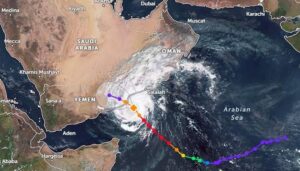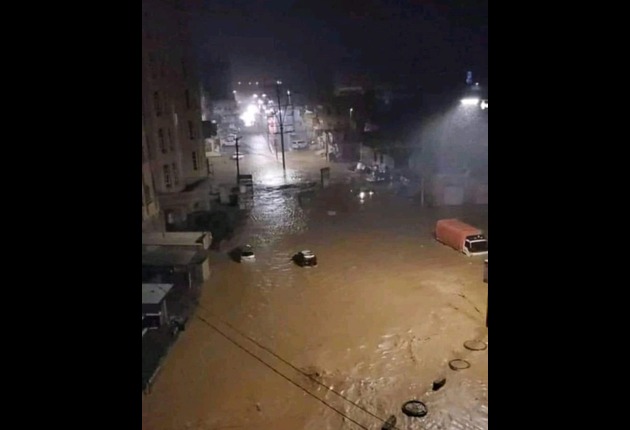Cyclone Tej Near Yemen- Saudi Border
Tropical Cyclone Tej made landfall along the coast between the coastal city of Al Ghaydah, the capital of Al Mahrah Governorate in south-eastern Yemen, and Salalah, the capital city of Oman’s Dhofar Governorate, and now it is situated near the Yemen and Saudi Arabia border, gradually weakening to the Deep Depression.
Yemen Meteorological Services reported that 406 mm of rain fell at Al Ghaydah Airport in the space of a few hours.
The Yemen Red Crescent Society said Cyclone Tej caused widespread destruction across Al Mahrah Governorate. Particularly badly affected are the districts of Al Ghaydah and Haswayn.
YRCS is working around the clock to respond and assist affected people. However, the situation in Al-Mahra is dire due to the impacts of #CycloneTej #Tej . pic.twitter.com/TBpkblBwoe
— Yemen Red Crescent (@YemenCrescent) October 24, 2023
Local media, quoting governorate officials, said 6 people were missing one person died in Haswayn District. Yemen Red Crescent Society (YRCS) reported at least 1,800 families displaced across the Al Mahrah Governorate.
“A devastating Cyclone Tej has swept through Al Mahrah Governorate, leaving a trail of destruction and displacing around 1800 families in its wake. The affected communities are now in dire need of immediate assistance to rebuild their lives,” a spokesperson for the Yemen Red Crescent said.
YRCS said their teams were working around the clock to respond and assist affected people. However, the situation in Al Mahrah was dire due to the impacts of Cyclone Tej. Severe weather conditions hindered access by ambulances and aid teams who said planes were necessary to rescue the stranded people and protect lives.

As of 24 October, some areas of Dhofar and Al Wusta Governorates in Oman saw heavy rain and some flooding. Roads were damaged, and power and communications networks were disrupted. Oman’s Civil Defense and Ambulance Authority rescued at least one person from a vehicle trapped in floods in Rakhyut.
In a period from October 22 to October 24, Rakhyut recorded 232 mm of rain, Dhalkut saw 203 mm, and Salalah saw 56 mm, according to figures from the Ministry of Agriculture, Fisheries, and Water Resources.
Yemen to receive more rain
According to the Yemen meteorological center, more rain and thunderstorms are expected over Yemen. next 24-hour forecast is given below.
Mountain Highlands
The atmosphere of waking to partly cloudy and relatively cool during the night and early morning especially on governorates (Saada, Imran, Sanaa, Damar, Al-Bayda and Dalah), with the possibility of scattered rainfall accompanied by thunder occasionally on parts of governorates (Hajja, Al-Mahwit, Rima, Damar, Eb, Taaz, Dalah and Bayda) and Shabwah, Ebin, Dialogue, easy to accuse, with the possibility of fog or watery sludge on parts of governorates (Taz, Ab, Hajj Warima).
Coastal areas
Partly cloudy to cloudy atmosphere, the chance is still set for scattered and variable severity rainfall accompanied by thunder sometimes on the coastal areas and the interior highlands of the governorates of (Al-Mahra and Hadramout) and it may include parts of the coast of Shabwa Governorate, the western coasts, the Sokotri Archipelago, and active to strong winds on the eastern and southern coasts and the Gulf Aden, where its speed is between 15 – 30) knots working on turbulent sea and tide rise, while moderate to active on the western coasts and the entrance to Bab Mandab.

Desert regions
Partly cloudy atmosphere with the possibility of cloud formation, which may be accompanied by scattered rainfall on parts of the deserts of governorates (Al-Mahra, Hadhramout and Shabwa) and the winds are moderate to exciting soil and sand activity.
Alerts and warnings
The National Meteorological Center and Early Warning alerts fellow citizens
from the presence in the belly of Odia and flood paths in the areas expected to rain and the need to take shelter from thunderstorms.
Motorists on mountainous roads have low horizontal visibility during rainfall or fog.
a relatively cold atmosphere during the night and early morning on parts of the mountainous and inner plateau.
from the disturbance of the sea and the high tide around the Socotra archipelago, the eastern and southern coasts, the entrance to Bab Mandab, and the southern parts of the west coast.
